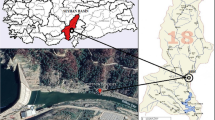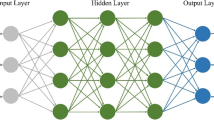Abstract
Forecasting the flow of rivers is essential for maintaining social well-being since their waters provide water and energy resources and cause serious tragedies such as floods and droughts. In this way, predicting long-term flow at measuring stations in a watershed with reasonable accuracy contributes to solving a range of problems that affect society and resource management. The present work proposes the MultiTask-LSTM model that combines the recurring model of Deep Learning LSTM with the transfer of learning MultiTask Learning, to predict and share information acquired along the hydrographic basin of Paraíba do Sul river. This method is robust for missing and noisy data, which are common problems in inflow time series. In the present work, we applied all 45 measurement stations’ series located along the Paraíba do Sul River basin in the MultiTask-LSTM model for forecasting the set of these 45 series, combining each time series’s learning in a single model. To confirm the MultiTask-LSTM model’s robustness, we compared its predictions’ results with the results obtained by the LSTM models applied to each isolated series, given that the LSTM presents good time series forecast results in the literature. In order to deal with missing data, we used techniques to impute missing data across all series to predict the 45 series of measurement stations alone with LSTM models. The experiments use three different forms of missing data imputation: the series’ median, the ARIMA method, and the average of the months’ days. We used these same series with imputing data in the MultiTask-LSTM model to make the comparison. This paper achieved better forecast results showing that MultiTask-LSTM is a robust model to missing and noisy data.
Access this chapter
Tax calculation will be finalised at checkout
Purchases are for personal use only
Similar content being viewed by others
Notes
- 1.
Downstream is the side where is directed the water flow and upstream is the part where the river is born. So, the mouth or outfall of a river is the most downstream point of this river, and the source is its most upstream point.
- 2.
- 3.
- 4.
- 5.
- 6.
References
Aghelpour, P., Varshavian, V.: Evaluation of stochastic and artificial intelligence models in modeling and predicting of river daily flow time series. Stoch. Environ. Res. Risk Assess. 34, 33–50 (2020). https://doi.org/10.1007/s00477-019-01761-4
Campos, L.C.D., Goliatt da Fonseca, L., Fonseca, T.L., de Abreu, G.D., Pires, L.F., Gorodetskaya, Y.: Short-term streamflow forecasting for Paraíba do Sul River using deep learning. In: Moura Oliveira, P., Novais, P., Reis, L.P. (eds.) EPIA 2019. LNCS (LNAI), vol. 11804, pp. 507–518. Springer, Cham (2019). https://doi.org/10.1007/978-3-030-30241-2_43
Cao, K., Hu, T., Li, Z., Zhao, G., Qian, X.: Deep multi-task learning model for time series prediction in wireless communication. Phys. Commun. 44, 101251 (2021)
Caruana, R.: Multitask learning. Mach. Learn. 28(1), 41–75 (1997)
Dorado-Moreno, M., et al.: Multi-task learning for the prediction of wind power ramp events with deep neural networks. Neural Netw. 123, 401–411 (2020)
Herschy, R.W.: Streamflow Measurement. CRC Press, Boca Raton (2014)
Jin, F., Sun, S.: Neural network multitask learning for traffic flow forecasting. CoRR abs/1712.08862 (2017). http://arxiv.org/abs/1712.08862
Kelman, J.: Water supply to the two largest Brazilian metropolitan regions. Aquatic Procedia 5, 13–21 (2015). At the Confluence Selection from the 2014 World Water Week in Stockholm
Kratzert, F., Klotz, D., Brenner, C., Schulz, K., Herrnegger, M.: Rainfall–runoff modelling using long short-term memory (LSTM) networks. Hydrol. Earth Syst. Sci. 22(11), 6005–6022 (2018). https://doi.org/10.5194/hess-22-6005-2018
Rezende, O.M., Miguez, M.G., Veról, A.P.: Manejo de águas urbanas e sua relação com o desenvolvimento urbano em bases sustentáveis integradas: estudo de caso dos Rios Pilar-Calombé, em Duque de Caxias/RJ. Revista Brasileira de Recursos Hídricos 18(2), 149–163 (2013)
Sherstinsky, A.: Fundamentals of recurrent neural network (RNN) and long short-term memory (LSTM) network. Physica D Nonlinear Phenomena 404, 132306 (2020)
Shireen, T., Shao, C., Wang, H., Li, J., Zhang, X., Li, M.: Iterative multi-task learning for time-series modeling of solar panel PV outputs. Appl. Energy 212, 654–662 (2018)
Yaseen, Z.M., El-shafie, A., Jaafar, O., Afan, H.A., Sayl, K.N.: Artificial intelligence based models for stream-flow forecasting: 2000–2015. J. Hydrol. 530, 829–844 (2015)
Yassuda, E.R.: Gestão de recursos hídricos: fundamentos e aspectos institucionais. Revista de Administração pública 27(2), 5–18 (1993)
Ye, R., Dai, Q.: Multitl-KELM: a multi-task learning algorithm for multi-step-ahead time series prediction. Appl. Soft Comput. 79, 227–253 (2019)
Zhang, J., Zhu, Y., Zhang, X., Ye, M., Yang, J.: Developing a long short-term memory (LSTM) based model for predicting water table depth in agricultural areas. J. Hydrol. 561, 918–929 (2018)
Zhao, Z., Luo, Z., Li, J., Chen, C., Piao, Y.: When self-supervised learning meets scene classification: remote sensing scene classification based on a multitask learning framework. Remote Sens. 12(20), 3276 (2020)
Author information
Authors and Affiliations
Corresponding authors
Editor information
Editors and Affiliations
Rights and permissions
Copyright information
© 2021 Springer Nature Switzerland AG
About this paper
Cite this paper
Dias Abreu, G., Pires, L.F., Campos, L.C.D., Goliatt, L. (2021). Multitask Learning for Predicting Natural Flows: A Case Study at Paraiba do Sul River. In: Marreiros, G., Melo, F.S., Lau, N., Lopes Cardoso, H., Reis, L.P. (eds) Progress in Artificial Intelligence. EPIA 2021. Lecture Notes in Computer Science(), vol 12981. Springer, Cham. https://doi.org/10.1007/978-3-030-86230-5_13
Download citation
DOI: https://doi.org/10.1007/978-3-030-86230-5_13
Published:
Publisher Name: Springer, Cham
Print ISBN: 978-3-030-86229-9
Online ISBN: 978-3-030-86230-5
eBook Packages: Computer ScienceComputer Science (R0)




